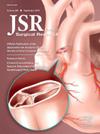生物补片覆盖软组织缺损胸壁重建:综述
IF 1.8
3区 医学
Q2 SURGERY
引用次数: 0
摘要
胸壁重建术(CWR)用于切除后胸壁的功能和/或美学损伤。本文综述了生物网在CWR中软组织覆盖的文献,以及在CWR中使用猪源性脱细胞真皮基质的报道。方法通过文献检索,确定了生物补片在CWR中的应用,并对猪脱细胞真皮基质和肌瓣重建胸壁大缺损的修复提供了专家意见。结果带生物补片的scwr可用于各种医疗条件下的软组织覆盖,包括肿瘤切除、创伤、先天性畸形,以及复杂的手术,如胸部大缺损、感染和胸壁既往放疗。与合成补片相比,生物补片在手术补片进行CWR患者的回顾性研究中报告了更少的总体并发症、感染和补片解释。然而,关于生物补片在CWR中使用的已发表数据有限,并且没有发表的随机对照试验来比较合成补片和生物补片在CWR中的应用。一个使用猪脱细胞真皮基质和肌肉瓣重建修复胸壁大缺损的案例研究表明,经过6年多的随访,结果成功。结论生物网在CWR中的应用有文献支持和专家意见。然而,需要更多关于各种补片的风险和益处的可靠临床数据来帮助外科医生选择补片。本文章由计算机程序翻译,如有差异,请以英文原文为准。
Chest Wall Reconstruction Using Biologic Mesh to Cover Soft Tissue Defects: A Narrative Review
Introduction
Chest wall reconstruction (CWR) is used in functional and/or aesthetic impairments of the thoracic wall following resection. This review summarizes literature for soft tissue coverage with biologic mesh in CWR and reports use of a porcine-derived acellular dermal matrix in CWR.
Methods
A literature search identified studies that use biologic mesh in CWR, and expert opinion for the use of a porcine acellular dermal matrix and muscle flap reconstruction to repair large chest wall defects is provided.
Results
CWR with biologic mesh is used to provide soft tissue coverage for various medical conditions, including oncologic tumor resections, trauma, congenital malformations, and in complex procedures, such as large thoracic defects, presence of infection, and prior radiation of the chest wall. Compared with synthetic mesh, fewer overall complications, infections, and mesh explantations have been reported with biologic mesh in retrospective studies of patients who underwent CWR with surgical mesh. However, there are limited published data on the use of biologic mesh for CWR, and there are no published randomized controlled trials comparing synthetic versus biologic mesh in CWR. A case study for the use of a porcine acellular dermal matrix and muscle flap reconstruction to repair large chest wall defects demonstrates a successful outcome with more than 6 y of follow-up.
Conclusions
Use of biological mesh in CWR is supported by literature and expert opinion. However, more robust clinical data on risks and benefits of types of mesh are needed to aid surgeons in selecting mesh.
求助全文
通过发布文献求助,成功后即可免费获取论文全文。
去求助
来源期刊
CiteScore
3.90
自引率
4.50%
发文量
627
审稿时长
138 days
期刊介绍:
The Journal of Surgical Research: Clinical and Laboratory Investigation publishes original articles concerned with clinical and laboratory investigations relevant to surgical practice and teaching. The journal emphasizes reports of clinical investigations or fundamental research bearing directly on surgical management that will be of general interest to a broad range of surgeons and surgical researchers. The articles presented need not have been the products of surgeons or of surgical laboratories.
The Journal of Surgical Research also features review articles and special articles relating to educational, research, or social issues of interest to the academic surgical community.

 求助内容:
求助内容: 应助结果提醒方式:
应助结果提醒方式:


